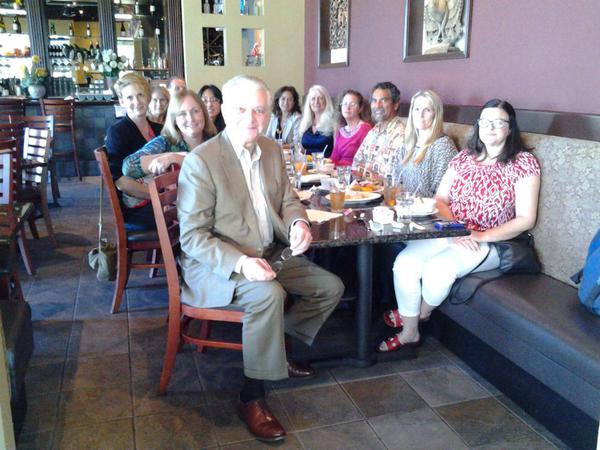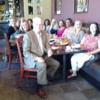 The SoCal ACEs Group held a fruitful first meeting Nov. 1 in San Diego featuring Dr. Vincent Felitti (front left in photo) and 11 other thinkers working on trauma-informed care from the mental health, health care, social outreach, justice system and more. Each and every individual contributed one unique and moving story after another as we went around the table for names and introductions, each of which I hope to report on in my next post, as it all hit me quite hard and it was a challenge just to keep up.
The SoCal ACEs Group held a fruitful first meeting Nov. 1 in San Diego featuring Dr. Vincent Felitti (front left in photo) and 11 other thinkers working on trauma-informed care from the mental health, health care, social outreach, justice system and more. Each and every individual contributed one unique and moving story after another as we went around the table for names and introductions, each of which I hope to report on in my next post, as it all hit me quite hard and it was a challenge just to keep up.
SoCal ACEs was preceded by the bi-monthly meeting of the San Diego Trauma-Informed Guide Team (SD-TIGT) facilitated by Betsy Knight, a manager at San Diego County Mental Health Services (right side, fourth back in red) (if my notes do not fail.) Dana Brown, passionate SD-TIGT community activist, supplied our photo (right side next to Betsy in blue). SD-TIGT is entirely volunteer and quite active in its mission "to promote the development and provision of trauma-informed services in San Diego County’s agencies." Their three focus areas are "the ACE Study, treating the whole person (not just the problem they came in with), and preventing cycling through systems of care." (www.elcajoncollaborative.org/uploads/1/4/1/5/1415935/sd_tigt_brochure2_f.pdf)
SD-TIGT is just now debuting a new on-line "eLearning" Trauma-Informed Care study program, forging new ground in helping all the dedicated clinicians who have been battling both trauma, and our poorly-informed health care system, for decades. I plan to write more about the issues raised at the SD-TIGT meeting in my next blog, but as I'm new, hope to have my text reviewed by SD-TIGT first.
Dr. Felitti had several eye-opening comments to our SoCal ACES group, on which I’ll report next blog.
Here let's emphasize one comment he’s made in public before; below are quotes from his 13-minute video “Adverse Childhood Experiences” at www.youtube.com/watch?v=GQwJCWPG478
Based on the ACE Study statistics, Dr. Felitti says, “The risk factors which can be attributed to Adverse Childhood Experiences include... about 2/3 of all alcoholism, about half of all drug abuse, and about 3/4s of intravenous drug use. In fact these are the risk factors that underlie the 10 most common causes of death in the United States. With an ACE score of zero you have a very medically un-interesting population: non-obese, non-smoking, non-alcoholic, non-diabetic, non-hypertensive, etc. No internist has a chance of making a living with that group. But with an ACE score of 4 or more, this is big medicine!
"And: the things that we call “risk factors” are in fact, effecting coping devises – this is an important idea.
"Many of these things termed 'public health problems' are in fact, personal solutions. Personal solutions to problems (ACEs) that are well-hidden, by time, by shame, by secrecy, by social taboo. Public health problem – personal solution? That's a pretty heavy-handed statement; I feel very comfortable making it.
"Essentially this is what psychoanalysts have been saying for a hundred years; but they've been saying it based on two cases, or four – and we're saying it based on 18,000 cases. One way of describing it would be: you have this large base of individuals with adverse childhood experiences, and most of them are going to be impaired as a result in some way, maybe socially, maybe emotionally, maybe cognitively....
"By the time they become adolescents and have some freedom, they ordinarily will try to do something to feel better, and hence initiate what we call 'health-risk behaviors,' but which might be called more properly 'self-help behaviors.' Those, over time, will produced disease and disability in many of them, and a significant portion of them will die early, as the ACE pyramid shows. " QED Dr. Felitti.
'Early Death' is of course, the top of the ACE pyramid.
So: are all these people broken? Are they the problem? Or is the system broken, and is it the problem?
-- Kathy Brous, www.AttachmentDisorderHealing.com/book/



Comments (5)